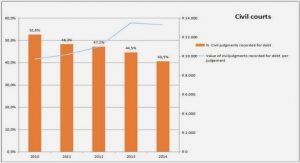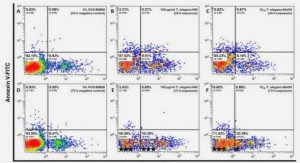Get Complete Project Material File(s) Now! »
Crystallization
Crystallization in polymers is promoted by linearity, close and regular fit of polymer chains, strong intermolecular forces, and stiff units in the chain which restrict rotation. In many ways the effect of crystallization are similar to those of crosslinking: reduction of solubility, flexibility, elasticity, and elongation, and increase of hardness, tensile strength and melting point.
The bonding of one chain to another by crystalline forces is different from that by true crosslinking in that the crystalline portion of the polymer may be disruption reversibly by heat (Saunders and Frisch, 1962).
Stiffness of chain units
Chain units having very limited rotational or configurational possibilities tend to stiffen polymer chains. Such units are best typified by aromatic rings, where the ring itself is a rigid unit. Such a stiffening effect favors high melting point, glass transition temperature, hardness, strength, and reduced elasticity and solubility. On the other hand, group which import a high order of flexibility because of unusual ease of rotation favor softness, flexibility, elasticity, low melting point, and low glass transition temperature. For samples of a very flexibility group is 13 the ether (Saunders and Frisch, 1962) and polydienes diol (Sartomer, 2005) such as polybutadiene diol.
Preparation of epoxidized natural rubber (ENR 2)
Field latex was diluted to 20%DRC, stabilized with Sinnopal NP 307 3 phr and stirred through a night at room temperature to eliminate ammonia and to homogenize for 12 h.
The epoxidation reaction was carried out in a three necked reactor with controlled speed stirrer at 300 rpm and 60 o C. The determined amount of formic acid (0.3 mol) was slowly dropped over about 15 min and then was stirred for 15 min after slowly added the desired amount of hydrogen peroxide (0.3 mol) under continuous stirring. The reaction time was varied to 1.30, 3 and 8 h. The epoxidized latex was coagulated in methanol and washed with water several times then washed with methanol, cut it into small pieces and finally dried in vacuum oven. The sample was analyzed with 1 H-NMR and 13C-NMR. The reaction is presented in Figure 4.3.
ABSTRACT (in English)
ABSTRACT (in French)
ABSTRACT (in Thai)
CONTENTS
LIST OF TABLES
LIST OF FIGURES
LIST OF ABBREVIATIONS
CHAPTER
1 INTRODUCTION
2 OBJECTIVES
3 LITERATURE REVIEW
3.1 Introduction
3.2 Properties of polyurethane
3.2.1 General
3.2.2 Physical and strength properties
3.2.2.1 Molecular interactions
3.2.2.2 Segment and domain structure
3.2.2.3 Crystallization
3.2.2.4 Stiffness of chain units
3.2.2.5 Chemical structure and composition
a) Isocyanates
b) Polyols
c) Chain extenders
3.2.2.6 Covalent crosslink
3.2.3 Thermal properties
3.2.3.1 General
3.2.3.2 Thermal analysis techniques
a) Differential scanning calorimeter (DSC)
b) Thermal gravimetric analyzer (TGA)
3.2.4 Acoustic property
3.2.4.1 Definition
3.2.4.2 Effect of parameter on acoustic property
3.2.4.3 Measuring of acoustic performance
3.3 Types of polyurethane
3.3.1 Polyurethane foams
3.3.1.1 Low density flexible foams
3.3.1.2 Low density rigid foams
3.3.1.3 High density flexible foams
3.3.2 Solid polyurethanes
3.3.2.1 Polyurethane elastomers
3.3.2.2 Adhesive, binder, coating, paints, lacquers
3.4 The formation of polyurethane foam
3.5 Method of polyurethane synthesis
3.5.1 One shot process
3.5.2 Prepolymer
3.6 Chemical reagents for polyurethane foams synthesis
3.6.1 Polyols
3.6.1.1 Polyether polyols
3.6.1.2 Polyester polyols
3.6.1.3 Hydroxyl terminated hydrocarbons
3.6.1.4 Renewable source polyols
3.6.2 Isocyanates
3.6.3 Catalysts
3.6.4 Chain extenders
3.6.5 Blowing agents
3.6.6 Surfactants
3.6.7 Others additives
3.6.7.1 Pigments
3.6.7.2 Fillers
3.6.7.3 Flame retardants
3.6.7.4 Antioxidants
3.7 Natural rubber based polyurethane
3.8 Introduction of natural rubber
3.8.1 Field natural rubber latex
3.8.2 Concentrated natural rubber latex
3.9 Telechelic liquid natural rubber
3.9.1 Definitions
3.9.2 Methods of telechelic liquid natural rubber synthesis
3.9.2.1 Oxidation in presence of redox system
3.9.2.2 Photochemical oxidation
3.9.2.3 High pressure and high temperature oxidation
3.9.3 Oxidation reaction in presence of reactive specific
cleavage of carbon-carbon double bond
3.9.3.1 Ozone cleavage
3.9.3.2 Cleavage by ruthenium oxide (RuO4)
3.9.3.3 Cleavage by periodic acid or lead acetate
3.9.3.4 Degradation via metathesis
3.9.4 Reactivity and reaction of telechelic liquid natural rubber
3.9.4.1 Modification of backbone
a) Maleinization
b) Chlorination
c) Grafting
d) Epoxidation
e) Hydrogenation
3.9.4.2 Modification of functional end-groups of telechelic liquid natural rubber
3.9.4.3 Chain extension reaction of telechelic liquid natural rubber
4 MATERIAL AND METHODS
4.1 Materials
4.2 Instruments
4.3 Experimental
4.3.1 Degradation of natural rubber in latex phase
4.3.1.1 Degradation of epoxidized natural rubber latex using periodic acid
4.3.1.2 Degradation of natural rubber latex using periodic acid and N-iodosuccinimide
4.3.2 Controlled degradation of natural rubber in solvent phase
4.3.2.1 Preparation of epoxidized natural rubber (ENR 2)
4.3.2.2 Preparation of carbonyltelechelic natural rubber (CTNR 3)
4.3.3 Modification of telechelic natural rubber
4.3.3.1 Preparation of hydroxytelechelic natural rubber (HTNR 4)
4.3.3.2 Preparation of epoxidized hydroxytelechelic natural rubber (EHTNR 5)
4.3.3.3 Preparation of hydrogenated hydroxytelechelic natural rubber (HHTNR 6)
4.3.3.4 Preparation of multifunctional hydroxytelechelic natural rubber (HTNR fn> 2) 7)
4.3.4 Analysis of telechelic natural rubber
4.3.4.1 Chemical structure characterization
a) Nuclear magnetic resonance spectroscopy
b) Fourier transforms infrared spectroscopy
c) MALDI-TOF mass spectroscopy
1) Principle
2) Limitations of MALDI
4.3.4.2 Determination of epoxide content
4.3.4.3 Determination of percentage of hydrogenation
4.3.4.4 Determination of functionality of hydroxytelechelic natural rubber
4.3.4.5 Determination of molecular weight
a) Nuclear magnetic resonance spectroscopy
1) Determination of molecular weight of CTNR3
2) Determination of molecular weight of HTNR 4
3) Determination of molecular weight of EHTNR 5
4) Determination of molecular weight of HHTNR 6
b) MALDI-TOF technique
c) Steric exclusion chromatography (SEC)
4.3.4.6 Thermal analysis
a) Differential scanning calorimeter (DSC)
b) Thermal gravimetric analyzer (TGA)
4.3.4.7 Viscosity of hydroxytelechelic natural rubber
4.3.5 Preparation of polyurethane foams
4.3.5.1 Effect of mixing speed in polyurethane foam process
4.3.5.2 Effect of molecular weight of precursors
4.3.5.3 Effect of epoxide content
4.3.5.4 Effect of amount and type of chain extenders
4.3.6 Properties of polyurethane foams
4.3.6.1 Density
4.3.6.2 Tensile strength and elongation at break
4.3.6.3 Compressive strength
4.3.6.4 Compression set
4.3.6.5 Cell size and cell structure
4.3.6.6 Acoustic properties
5 RESULTS AND DISCUSSIONS
5.1 Degradation of natural rubber
5.1.1 Degradation of natural rubber in latex
5.1.2 Degradation of natural rubber in organic solvent
5.1.2.1 Preparation of epoxidized natural rubber
5.1.2.2 Cleavage reaction of partially epoxidized natural rubber
5.2 Modification of telechelic natural rubber
5.2.1 Reduction of CTNR 3
5.2.3 Epoxidized of carbon-carbon double bonds of HTNR 4
5.2.2 Catalytic hydrogenation of carbon-carbon double bonds of HTNR 4
5.2.4 Determination of functionality of HTNR 4
5.2.5 Reduction of EHTNR 5
5.2.6 MALDI-TOF MS analysis
5.2.7 Viscosity and thermal properties of precursors
5.3 Preparation of polyurethane foams
5.3.1 Synthesis and characteristic of HTNR and commercial precursors based polyurethane foams
5.3.1.1 Effect of mixing speed on the morphological properties of polyurethane foams
5.3.1.2 Characterization of polyurethane foams
5.3.2 Physico-mechanical properties of polyurethane foams
5.3.2.1 Effect of molecular weight of precursors
5.3.2.2 Effect of epoxide content
5.3.2.3 Effect of type and amount of chain extenders
5.3.3 Thermal properties of polyurethane foams
5.3.4 Acoustic properties of polyurethane foams
6 CONCLUSIONS
REFERENCES
APPENDINCES






